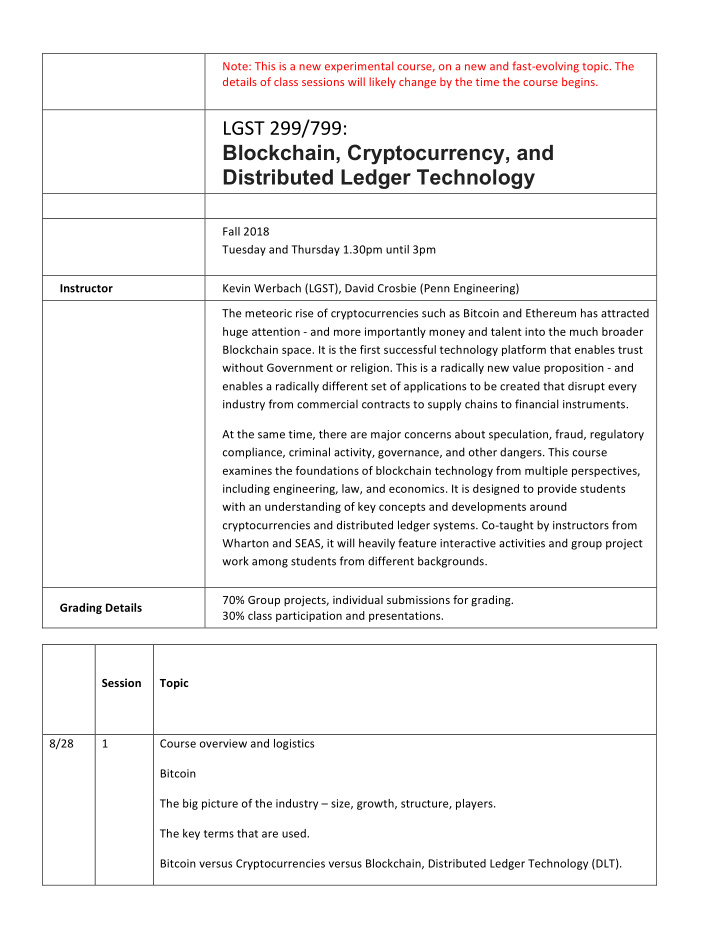



Note: This is a new experimental course, on a new and fast-evolving topic. The details of class sessions will likely change by the time the course begins. LGST 299/799: Blockchain, Cryptocurrency, and Distributed Ledger Technology Fall 2018 Tuesday and Thursday 1.30pm until 3pm Instructor Kevin Werbach (LGST), David Crosbie (Penn Engineering) The meteoric rise of cryptocurrencies such as Bitcoin and Ethereum has attracted huge attention - and more importantly money and talent into the much broader Blockchain space. It is the first successful technology platform that enables trust without Government or religion. This is a radically new value proposition - and enables a radically different set of applications to be created that disrupt every industry from commercial contracts to supply chains to financial instruments. At the same time, there are major concerns about speculation, fraud, regulatory compliance, criminal activity, governance, and other dangers. This course examines the foundations of blockchain technology from multiple perspectives, including engineering, law, and economics. It is designed to provide students with an understanding of key concepts and developments around cryptocurrencies and distributed ledger systems. Co-taught by instructors from Wharton and SEAS, it will heavily feature interactive activities and group project work among students from different backgrounds. 70% Group projects, individual submissions for grading. Grading Details 30% class participation and presentations. Session Topic 8/28 1 Course overview and logistics Bitcoin The big picture of the industry – size, growth, structure, players. The key terms that are used. Bitcoin versus Cryptocurrencies versus Blockchain, Distributed Ledger Technology (DLT).
Strategic analysis of the space – who are the major players (Blockchain platforms, regulators, application providers, etc.) Bitcoin, HyperLedger, Ethereum, Litecoin, Zcash. Etc. The major application: currency, identity, chain of custody. 8/30 2 Trust and Vunerability Short history of the scaling out of human trust. High and Low trust societies Types of Trust model: Peer-to-Peer, Leviathan, and Intermediary. 9/4 3 Introduction to Cryptography. • Brief history, and goals of cryptography • Symmetric-key cryptography • Public-key cryptography • Digital Signatures 9/6 4 Cryptography continued • Hash functions Verifying data 9/11 5 The history of money – why it exists, what it does, why people care, where it is going? Money as a store of value versus money for transactions (buying goods and service). Asset backed currency, gold standard, Bretton-Woods, hyper-inflation. Modelling money flow (velocity of money) 9/13 6 Application of Cryptography to Blockchain • Using hash functions to chain blocks • Digital Signatures to sign transactions • Using hash functions for Proof-of-Work. 9/18 7 Consensus mechanisms – distributed trust in data. Introduction to crypto economics there (proof of work and proof of stake), as well as the distinction between those models and non-economic solutions like PBFT, Ripple’s approach, and others). • Byzantine agreement • Extensions of BFT (Ripple, Stellar)
9/20 8 Blockchain Dynamics • Public and private blockchains • Hard and soft forks • Sharding Side chains 9/25 9 Verifiers – trust, cost and speed. • Proof of work and other models. 10/2 10 Distributed Virtual Machines, Smart Contracts, Oracles 10/4 11 Basics of contract law. Smartcontracts and their potential Trust in Algorithms, the impact on society. How existing legal systems could be integrated? OpenZeplin, OpenLaw. 10/9 12 Writing smartcontracts, what is going on under the hood. The rigidity of coding versus the nuance of law, and how those two domains might be bridged. Colored tokens, Cryptokitties, Solidity, and Chaincode. 10/11 13 Putting the technology together – examples of implementations with their tradeoffs. From finance to law to chain of custody to organizations (DAO – distributed companies). Impact in countries with a high degree of trust in the state and state institutions – and those with a very low level of trust. 10/16 14 Guest Lecture – Blockchain 10/18 15 Assets (fiat currencies, property, equity, securities). Supply and demand. Inflation and deflation Valuations and bubbles. Cyrptoeconomics – moving beyond its use in verifying the blockchain– motivating participants, creating investment funds, storing value Creating and using tokens and coins. 10/23 16 Regulation
Securities law – Howey test, the US process of registration, accredited investors. SEC, Finra, FTC, CFTC. Money laundering, Know Your Customer, embargos, the role of the US in setting global financial regulation, inter-banking. 10/25 17 Regulation – Europe and Asia Regulation in centralized systems. Privacy laws, Data protection laws. The competition between regulators 10/30 18 Regulation by code versus law. The role of Governance. 11/1 19 Initial Token Offerings: Structure Process Risks 11/6 20 ITOs – continued An analysis of the current market. What is best practice today? How does traditional funding (VC, industry) fit in? 21 11/8 Review of projects to date. What have we learnt from these projects? What is best practice? Where are the largest areas of legal, financial, technology, and regulatory uncertainty? 11/13 22 Guest Lecturer – Lawyer or regulator. 11/15 23 Exchanges, interfacing with Fiat currency Centralized and Decentralized exchanges. Stablecoins (essentially asset backed cryptocurrencies). Guest Lecturer 11/20 24 Supply Chain and Identity on Blockchain
How Blockchain interacts with existing infrastructure – where does it compete versus extend. Ensuring trust in blockchain data (just because it is on a blockchain does make it true). 11/27 25 Scaling Blockchain – reading and writing data. Differentiate nodes, sparse data and Merkle trees. Fixing on the fly – fixes to current implementations: Layer 2 solutions (Lightning and Ethereum state channels.) Bitcoin scaling debate (Segwit2x etc.). The realities of hard forks for scaling, and bugs. 11/29 26 Presentations 12/4 27 Presentations 12/6 28 Where does this industry go from here? What are the broader implications on technology, finance, and law (trust in algorithms versus trust in people)? What are the moral issues that are raised?
Recommend
More recommend